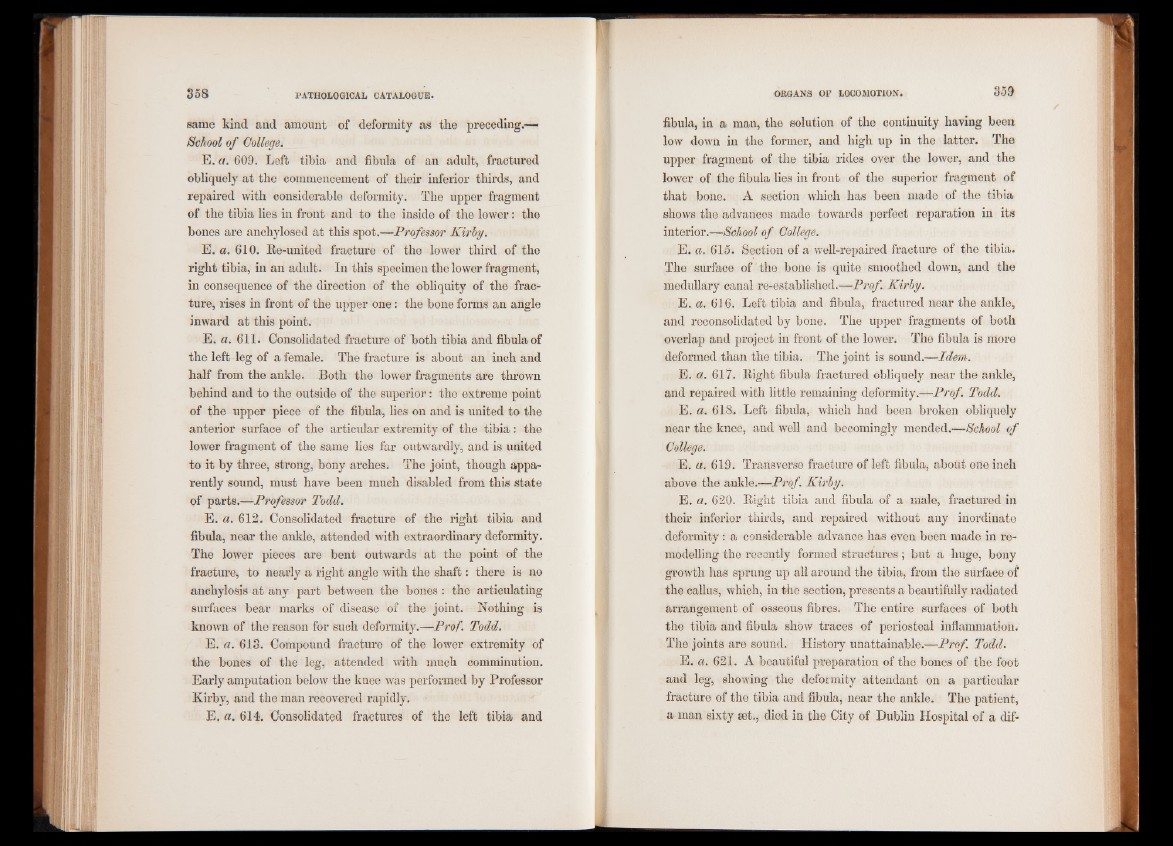
same kind and amount of deformity as the preceding.—
School of College.
E. a. 609. Left tibia and fibula of an adult, fractured
obliquely at the commencement of their inferior thirds, and
repaired with considerable deformity. The upper fragment
of the tibia lies in front and to the inside of the lower: the
bones are anchylosed at this spot.—Professor Kirby.
E. a. 610. Re-united fracture of the lower third of the
right tibia, in an adult. In this specimen the lower fragment,
in consequence of the direction of the obliquity of the fracture,
rises in front of the upper one: the bone forms an angle
inward at this point.
E. a. 611. Consolidated fracture of hoth tibia and fibula of
the left leg of a female. The fracture is about an inch and
half from the anlde. Both the lower fragments are thrown
behind and to the outside of the superior: the extreme point
of the upper piece of the fibüla, hes on and is united to the
anterior surface of the articular extremity of the tibia: the
lower fragment of the same lies far outwardly, and is united
to it by three, strong, bony arches. The joint, though apparently
sound, must have been much disabled from this state
of parts.—Professor Todd.
E. a. 612. Consolidated fracture of the right tibia and
fibula, near the ankle, attended with extraordinary deformity.
The lower pieces are bent outwards at the point of the
fracture, to nearly a right angle with the shaft: there is no
anchylosis at any part between the bones : the articulating
surfaces bear marks of disease of the joint. Nothing is
known of the reason for such deformity.—Prof. Todd.
E. a. 613. Compound fracture of the lower extremity of
the bones of the leg, attended with much comminution.
Early amputation below the knee was performed by Professor
Kirby, and the man recovered rapidly.
E. a. 614. Consolidated fractures of the left tibia and
fibula, in a man, the solution of the continuity having been
low down in the former, and high up in the latter. The
upper fragment of the tibia rides over the lower, and the
lower of the fibula lies in front of the superior fragment of
that bone. A section which has been made of the tibia
shows the advances made towards perfect reparation in its
interior.—School of College.
E. a. 615. Section of a well-repaired fracture of the tibia.
The surface of the bone is quite smoothed down, and the
medullary canal re-established.—Prof. Kirby.
E. a. 616. Left tibia and fibula, fractured near the ankle,
and reconsolidated by bone. The upper fragments of both
overlap and project in front of the lower. The fibula is more
deformed than the tibia. The joint is sound.—Idem.
E. a. 617. Right fibula fractured obliquely near the ankle,
and repaired with little remaining deformity.—Prof. Todd.
E. a. 618. Left fibula, which had been broken obliquely
near the knee, and well and becomingly mended.—School of
College.
E. a. 619. Transverse fracture of left fibula, about one inch
above the ankle.—Prof. Kirby.
E. a. 620. Right tibia and fibula of a male, fractured in
their inferior thirds, and repaired without any inordinate
deformity: a considerable advance has even been made in remodelling
the recently formed structures; but a huge, bony
growth has sprung up all around the tibia, from the surface of
the callus, which, in the section, presents a beautifully radiated
arrangement of osseous fibres. The entire surfaces of both
the tibia and fibula show traces of periosteal inflammation.
The joints are sound. History unattainable.—Prof. Todd.
E. a. 621. A beautiful preparation of the bones of the foot
and leg, showing the deformity attendant on a particular
fracture of the tibia and fibula, near the ankle. The patient,
a man sixty set., died in the City of Dublin Hospital of a dif